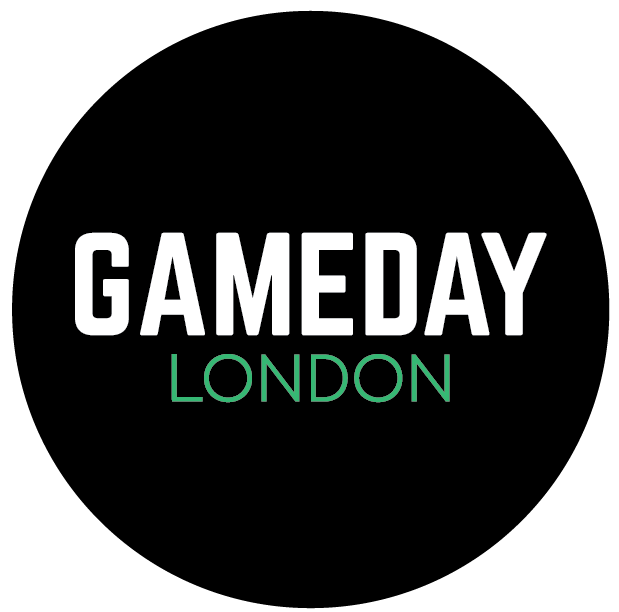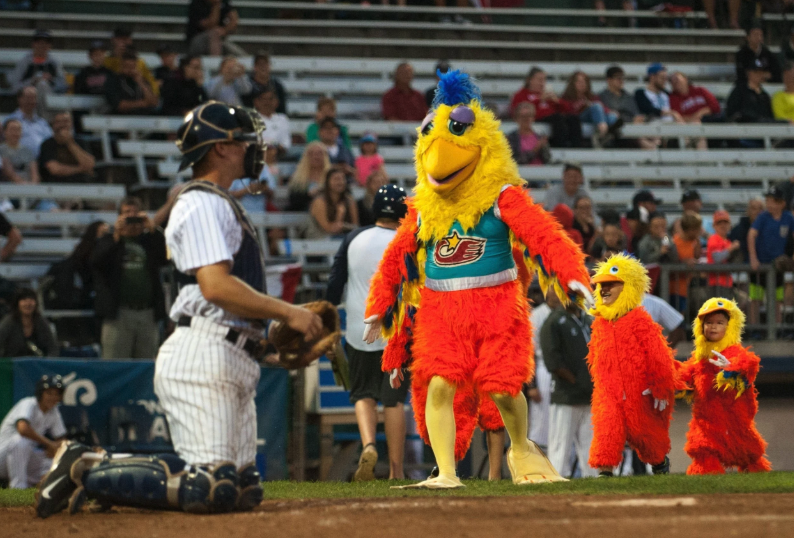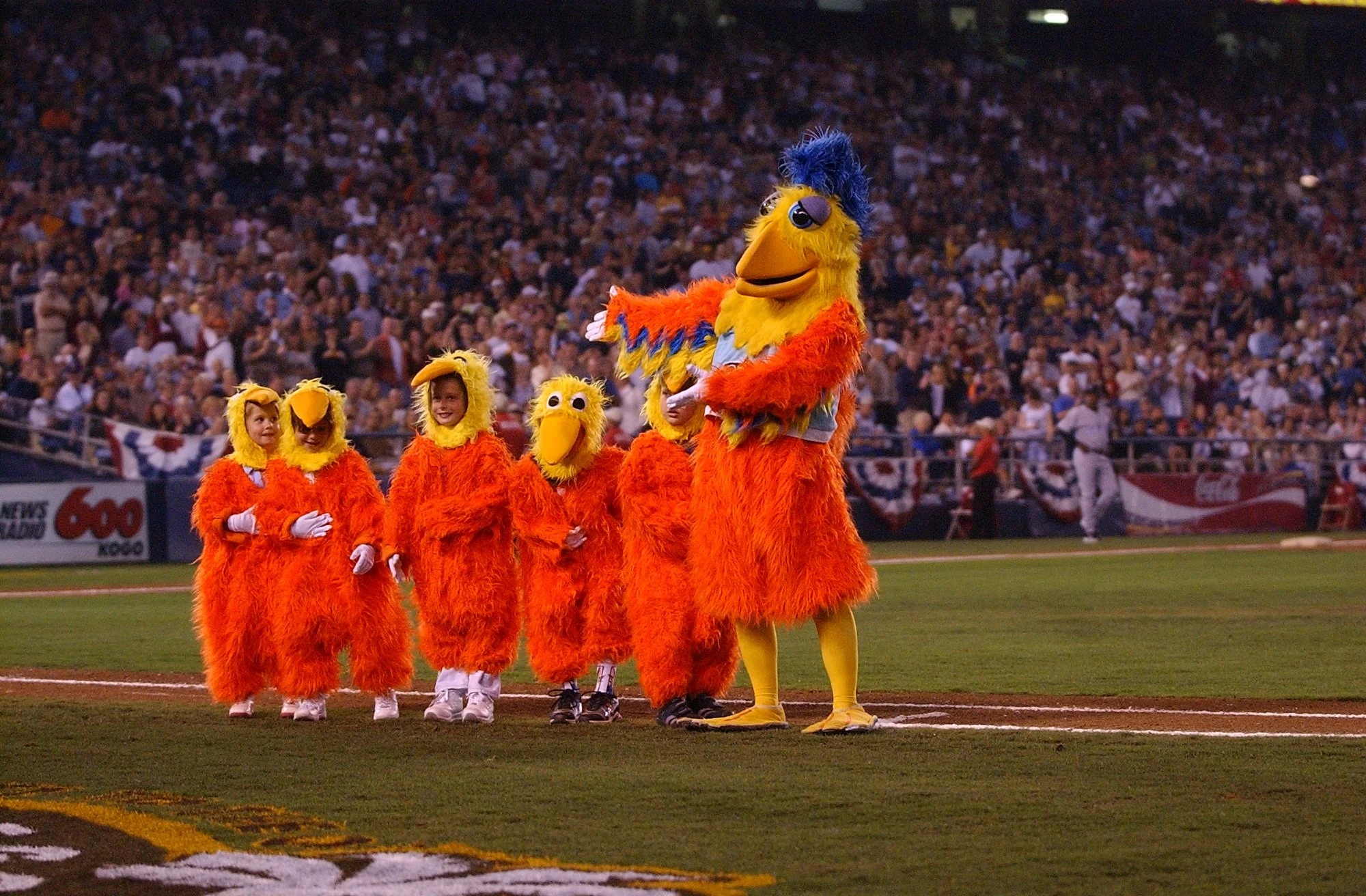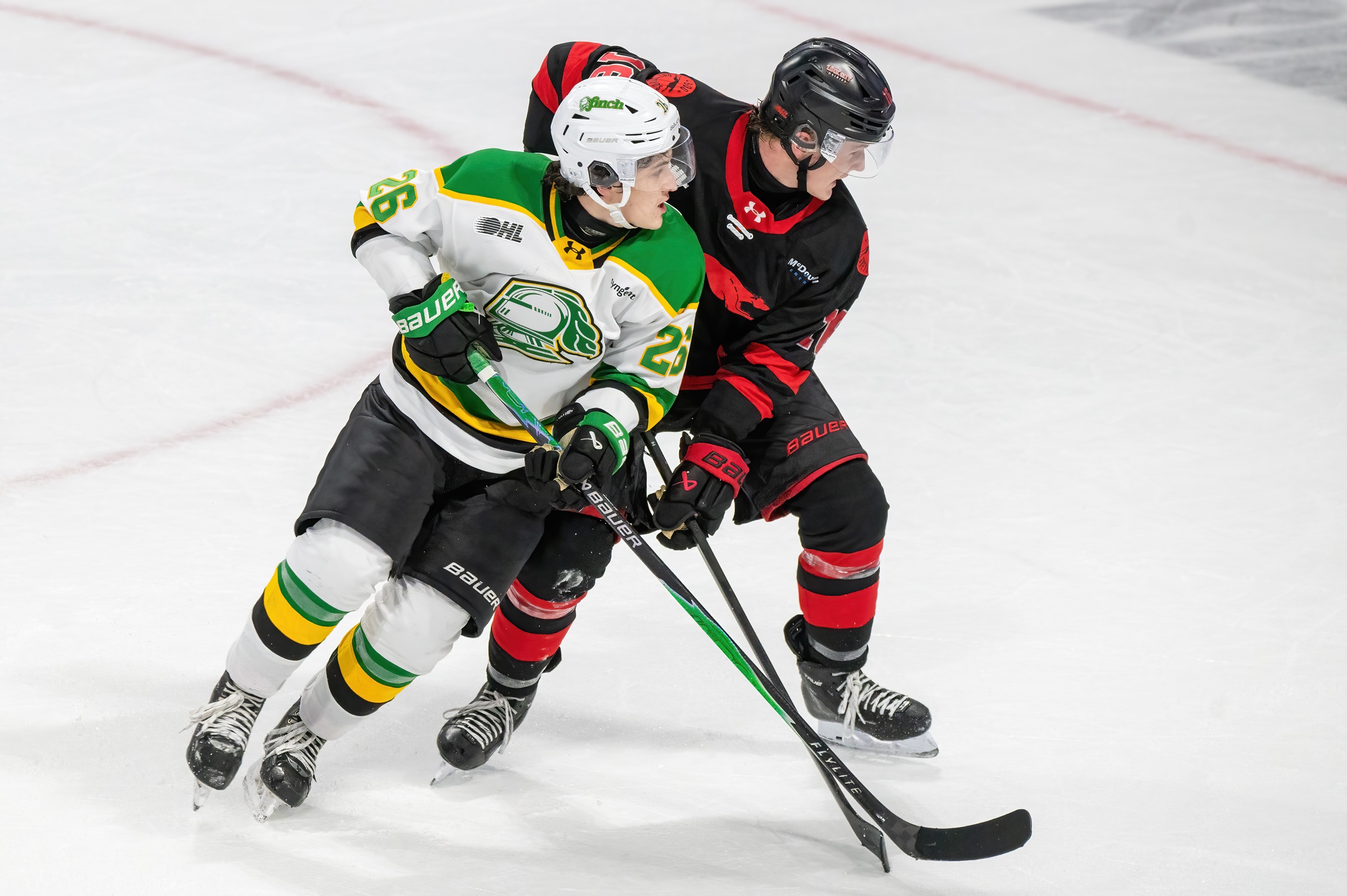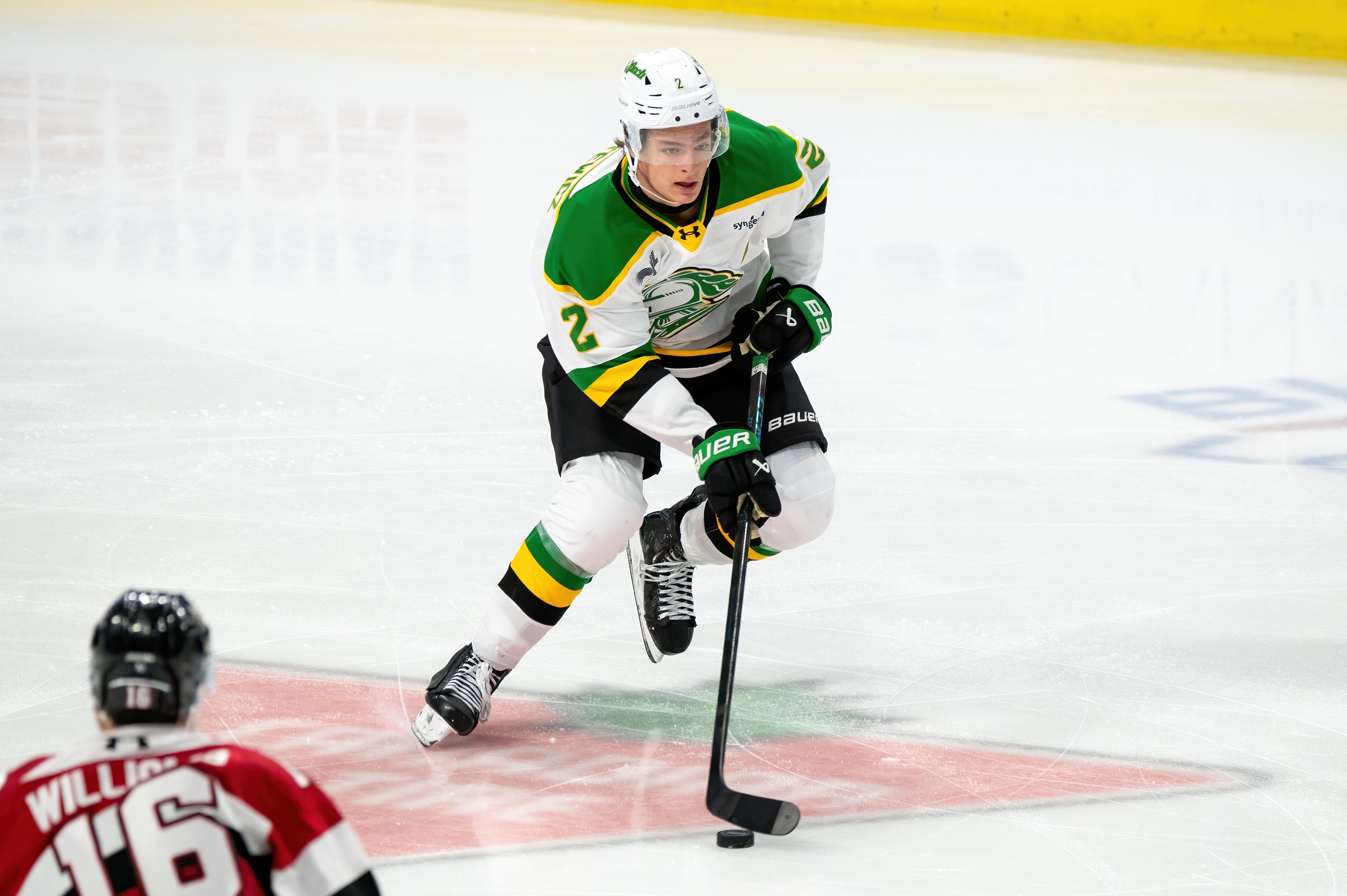|
Getting your Trinity Audio player ready...
|
London-born Ted Giannoulas pioneered the on-field mascot. The ‘class clown’ from the Forest City became the sports world’s most recognizable performer: The Chicken. This spring marks 50 years since he first put on the suit.
You learn a lot about people when you meet millions of them – even when you’re in a chicken suit.
“People have a very, very good heart – an instinctively good heart,” says Ted Giannoulas. “Everyone’s first language is laughter, and it was heartening to see that. I would go to countries where I couldn’t speak a single word of their language, or know their culture, but they came to the ballpark or the arena and they laughed. It was no different than what I saw anywhere in the United States or Canada.”
For the last 50 years, Giannoulas, a London native, and his alter ego – The Famous Chicken, also known as The San Diego Chicken – have brought that laughter to more than 60 million people around the world. Along the way, whether performing for classmates at Empress and London Central, or fans of all ages in the world’s biggest stadiums, Giannoulas has learned a lot about the human spirit.
“People are kind and gracious and good. Keep in mind, they’re putting up with this unorthodox, bizarre idea of a guy in a chicken suit in front of them – and the fantastic majority of them went along with the joke. This thing reached all ages, every demographic from toddlers to senior citizens and everybody in between. Everyone seemed to share the same heart, the same spirit, and the same laughter.”
* * *
In 1951, Giannoulas’ father immigrated to London from Greece with just $17 to his name. Bringing his then-girlfriend over the following year, the couple married soon after her arrival, with the cab driver who drove them to the church serving as their best man. Ted Giannoulas was born on Aug. 17, 1953. Two sisters followed.
Like a lot of immigrant families, his parents held numerous jobs to build a life in their new home. His mother worked as a seamstress, as well as in an ice cream factory making cones. His father was a self-taught carpenter, but also ran several successful diners around the city.
The Greek community was starting to grow in London, and so the family had plenty of friends and relatives nearby, and seemingly at all points between Detroit and Ottawa.
Giannoulas grew up on Essex Street in the shadow of Western University. Attending Empress Public School, then London Central, he played and loved a variety of sports. Although his dad wasn’t a sports fan, the young Giannoulas followed his favourite players and teams by reading copies of The Sporting News from cover to cover. For three summers, 1965-67, he worked for 25 cents a game changing Labatt Park’s manual scoreboard when the IBL’s London Pontiacs played at home.
It was also in the Forest City, he says, that his sense of humour truly began to emerge.
“For the last 50 years, I just brought my Canadian schoolboy sense of humour to what I was doing. That made all this happen. One of the funniest years I’ve ever had in my life was my year at Central with my classmates in Grade 9C, the funniest class I had ever, ever been in. Everybody was just a goof, a comic, all class clowns, if possible. It was amazing chemistry. Yeah, some of us were obnoxious at times – and that includes me – but, in retrospect, it was a funny, enjoyable time.”
There’s no question that the city’s classrooms shaped him. He still remembers the names of teachers and pals who meant so much.
“I considered myself very lucky to have grown up in a town like London. I think back to all the teachers I had and how great they were, and the patience they showed us, even when we goofed around, or were sometimes wild and obnoxious and stupid. Those teachers were saints,” Giannoulas said.
He still credits classroom penmanship drills for shaping his handwriting and a near-perfect signature that he’s written tens of thousands of times across photos. In other words, there are no chicken-scratch autographs from this guy, thanks to London schools.
“London wasn’t considered a small town, but it had that feel during an enjoyable period of my life,” he said. “I learned quite a bit – as we all do in our formative years – about how gracious people can be.”
London remained home until his dad took two trips to Southern California – one in 1965, another in 1966 – to visit Ted’s godparents who had relocated there from Canada. Following that second trip, his dad returned home and informed the family that “I found Athens in America, and we’re going.”
With green cards secured, and belongings packed in the station wagon, the family made the seven-day drive south in 1969.
Once settled in San Diego, 16-year-old Giannoulas’ passion for sports grew as he became interested in writing. In high school, he worked on the school paper, later becoming its sports editor. There were some honours and awards along the way, and so he started to see sports journalism as an exciting possibility. There was no better way to get a front-row seat for the games he loved.
Or so he thought.
* * *
It took 90 seconds for it all to begin.
With the campus of San Diego State virtually deserted heading into Easter Break 1974, Giannoulas decided to go hang out at the campus radio station where he volunteered. He wasn’t in the studio a couple of minutes when a representative from a local rock’n’roll radio station, KGB-FM, showed up and said to the five students sitting around shooting the breeze, ‘Who wants to come and dress up in a chicken suit?’
The station was going to the San Diego Zoo and giving away Easter eggs and candy for two bucks an hour.
The 5-foot-4 Giannoulas was the first to volunteer.
“Just getting hired was something. Had I not showed up there, the day before Easter break, none of this happens,” he laughed. “He just picked me right out of the blue. He said, ‘Hey, I’ll take you. You’re the short guy. You’ll fit the suit best of all. Had I just gone home like everybody else, I would have missed that opportunity.”
For Giannoulas, the opportunity was about getting his foot in the door at a real radio station. A rock station, no less.
“I wasn’t looking to work in a costume,” he said. “I just wanted to get in at a real radio station. The rock’n’roll was icing on the cake. If it was a news station, if it was a TV station, if it was a classical music station, whatever, I would have volunteered. If it meant dressing up in a chicken suit to get started for a rock’n’roll radio station, so be it.
“We all wanted to get into the broadcasting business one way or another. And here was an opportunity. If they said, ‘Hey, you have got to empty trash cans or shine the records or sweep the parking lots,’ I would have still volunteered.”
After a year and a half plugging along making community appearances in a stiff, uncomfortable costume, Giannoulas convinced the station to let The Chicken go to baseball games. That was never the plan. Of course, the original plan called for just 10 days of events and then The Chicken was done – but there he was, weeks later, and still popular with the public.
“When you apply yourself and give 100 per cent good faith energy into something, people notice.”
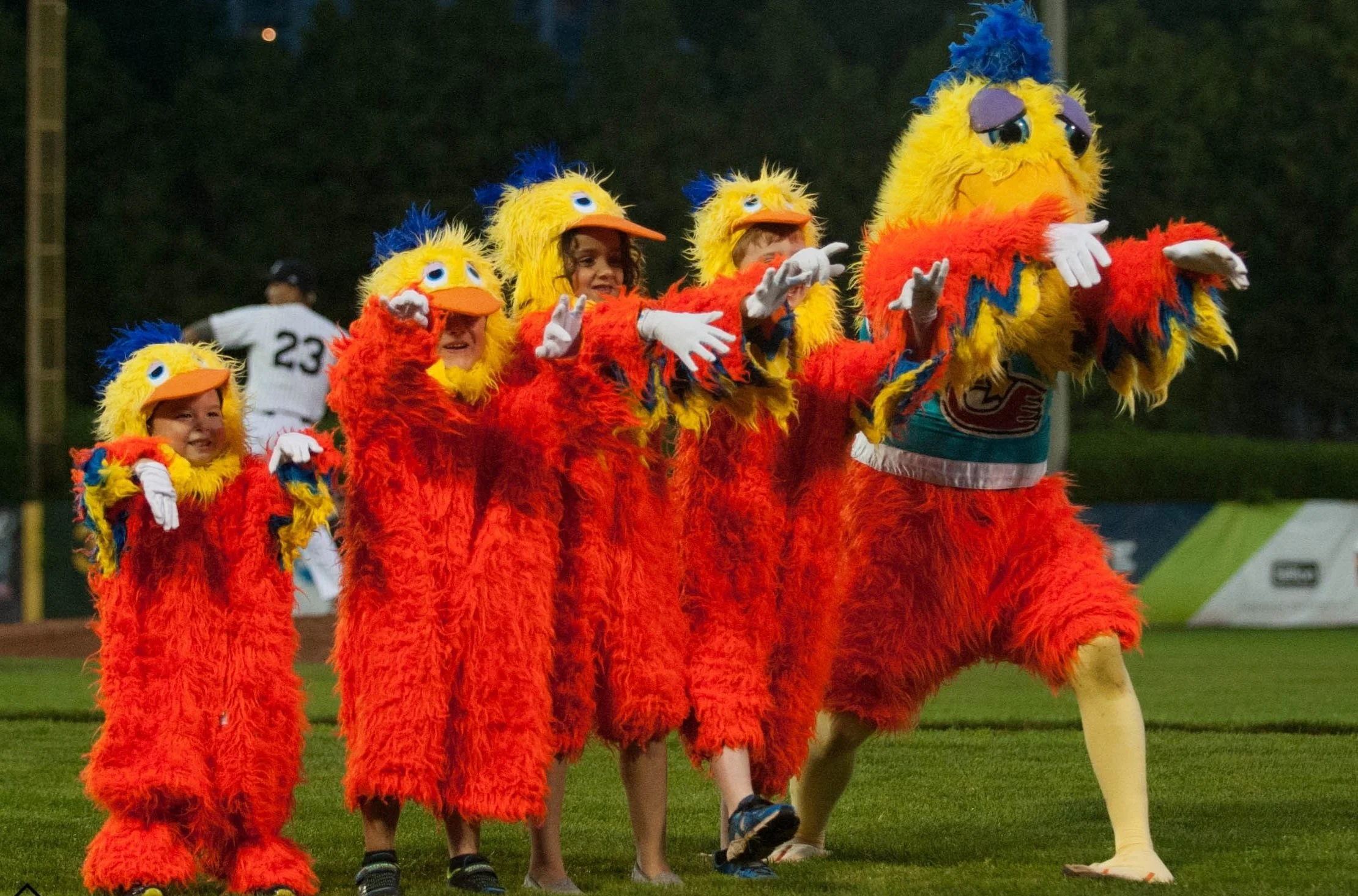
* * *
At the same time Giannoulas and family arrived in the city in 1969, San Diego welcomed the Padres as one of four Major League Baseball expansion teams (including the Montreal Expos, Kansas City Royals, and Seattle Pilots). Despite initial fan excitement, the team struggled on the field, finishing last in the NL West in its first six seasons, losing 100 games or more four times during that stretch.
For the early 1970s Padres, the show in the stands was often much more entertaining than what was happening between the white lines. The Chicken started going to Padres games, walking around the grandstands, interacting with fans. He would goof off with peanut vendors, polish a bald fan’s head with a towel, or dance. Anything for fun.
“It was really off the wall back then. It was unprecedented. Absolutely. No one had ever seen anything like this. We got a kick out of it.”
The key, he said, was that he sought to make fans part of the show from the start.
“I decided I’m going to engage them, make them part of this spectacle because they are 50 per cent of it. Forget what the players are doing out there on the field, on the ice, or on the court. These fans have equal value.”
Giannoulas continued, “When I performed, I reminded people that this was all a game, and I was the physical embodiment of it. I wanted everybody to leave everything else outside the doors, and that included headlines and politics and everything else like that. This was a fun zone. This is where we all get to goof off. You. Me. The players. Everyone. That’s the spirit I brought into the arena with me. I always saw that space as a closed-off domain from the rest of the world.”
You could argue that Giannoulas/The Chicken was one of the original ‘gorilla marketers,’ promoting the station’s brand in an unorthodox way. All over the city, his public appearances drew fans, seeking album giveaways, concert tickets, movie passes, whatever he was sent out to promote and provide.
Giannoulas was taking classes by day and then making public appearances and going to games as The Chicken at night and on weekends – all still for $2 an hour. Success led to a better suit, a more flexible and breathable foam form compared to the original paper mache suit.
“Then something mysterious began happening. Days went into weeks and weeks went into months. The ratings started rising at KGB. And The Chicken just got more popular.”
* * *
It’s hard to explain the scope of the career that followed over the next 50 years.
Named among the Top 100 Most Powerful People in Sports of the 20th Century by The Sporting News – a list that included Muhammad Ali, Babe Ruth, Jesse Owens, and Wayne Gretzky – Giannoulas has played to more than 60 million people in live attendance.
He met presidents and prime ministers, royalty and rock stars, and every imaginable sports star.
He nearly caused an international incident by taunting Soviet hockey players during a 1977 exhibition game with the San Diego Mariners. (It seems Cold War-era Soviets didn’t take kindly to being the butt of jokes from a guy in a chicken suit with the letters ‘KGB’ – even if just a radio station’s call letters – emblazoned across the chest.)
He appeared on Letterman, Carson, and Regis multiple times.
He jammed with Buffett, McCartney, Hagar, The Ramones, and hundreds of others. One night in 1976, Elvis Presley stopped mid-concert to laugh at The Chicken’s dancing escapades in the aisles of the San Diego Sports Arena.
Yet, strangely, fame never superseded fun and the fans in his mind.
“I was in awe of a lot of people I met – even people you wouldn’t read about. I’d be in awe of seeing a mom and dad come up with six kids to get autographs. Oh man, what must it be like in that car? What must it be like in that household every day?” Giannoulas said.
Rest assured, if you saw The Chicken over the last 50 years, it was Giannoulas inside the costume “99 and a half per cent of the time.” That’s more than 7,000 games. On top of that number, he’s probably done 20,000 parades, trade shows, and conventions.
“I did so many that people thought there were two or three of me.”
No one ever stepped in for him during a game appearance – never missed a one, he proudly boasts – but there were a handful of times where booking and travel necessitated “special arrangements,” including once where his assistant rode in costume during the Citrus Bowl Parade. (Giannoulas did make it in time for the game that evening.)
“He didn’t even have to get out of the car – just ride and wave. I thought he could handle it,” he laughed.
* * *
The Chicken could have died in 1979.
KGB-FM abruptly fired Giannoulas in May 1979, and brought a lawsuit alleging breach of employment contract, unfair competition, servicemark infringement, and other causes. The station sought damages and was granted a temporary injunction preventing Giannoulas from appearing in a chicken suit.
Essentially, the station sought to end his career not only around San Diego, but around the world. It was a massive overreach on copyright and intellectual property.
“I’m asking my own attorneys at the time, ‘how does this station have jurisdiction over what goes on in Europe or Asia or Russia? Are they going to come and arrest me if I’m walking the streets of Moscow with a with a chicken suit on?’”
In the court of public opinion, the firing was seen as petty, and the court case as even more vindictive. As the San Francisco Chronicle wrote at the time:
“(Giannoulas) was suspended Monday, and KGB is looking for a new man behind the outfit. Which is about as hopeless as having an understudy step in for Lawrence Olivier. The Chicken suit itself is amusing, but Giannoulas’ artistry is what makes it work. He’s a dancer, a showman, and an athlete, and his timing is flawless. When the Padres return home May 3, there’s a pretty good chance he’ll be there. A replacement? Forget it.”
Everyone knew that this fight was not over the body, but the intellectual property of the man inside who brought The Chicken to life.
“The station didn’t care,” Giannoulas said. “In 1970s radio, you were only concerned about your turf – that meant as far as our signal went. I argued that we didn’t want The Chicken to become like a department store Santa Claus where you see it everywhere. They didn’t care, but I cared.”
On April 12, 1980, the California Court of Appeal agreed with Giannoulas and lifted the injunction preventing him from appearing as The Chicken. The court wrote:
“This station claims a perpetual monopoly on chicken routines in local counties; if that claim were not preposterous enough, it further contends injury because its former employee has made it nationally famous. The claim of irreparable injury in this context is ridiculous.”
The court continued, “We are not in a position to determine the relative inputs of KGB and Giannoulas to the KGB chicken concept, but we note the inevitable significance of the performer’s contribution to a fluid, changing, clownish role of the type here considered. It is created spontaneously through gestures, movements, and responses to changing situations. KGB cannot be said to own such a routine.”
This wouldn’t be The Chicken’s last court appearance – there was that unpleasantness with Barney the Dinosaur, among others – but KGB Incorporated v. Giannoulas (1980) was most certainly the most significant. It is still a landmark case regarding copyright and intellectual property.
To celebrate his newfound freedom, Giannoulas planned ‘The Grand Hatching’ event on June 29, 1979, at a Padres game. Per his request, Giannoulas was to receive an attendance-based bonus if the game drew more than the team’s average crowd of 18,000. The event featured The Chicken emerging from an eight-foot Styrofoam egg during an elaborate pregame ceremony. More than 41,000 fans sold out Jack Murphy Stadium to witness the spectacle.
“The next day, the Padres cut me a check for more than $40,000.”
* * *
Originally, there was no chicken in The Bunch.
Filmed at Pepperdine University in August 1980, The Baseball Bunch was an MLB-produced series that educated kids on the game through sketches, highlights, and plenty of famous guests. But when the pilot episode proved too dry for kids, they called Giannoulas. With a date open on his calendar, he met with producers.
“They just gave me the script and told me to improvise around it. ‘We don’t have time to rewrite it. Just improvise. Fit yourself in where you think you do, where it would work,’ they told me. And so, improvise is what I did.”
The show was an instant hit with focus groups, becoming an iconic program for kids across 50 episodes over five seasons (1980-85). The show won three Emmy Awards. Nearly every star player from the era appeared on the show, ranging from George Brett and Cal Ripken Jr., to Tom Seaver and Ozzie Smith. Reggie Jackson was the only player who declined an invitation to be on the show. (Turns out, he wanted more money than the show’s honorarium allowed.)
Former Montreal Expo all-star Andre Dawson was Giannoulas’ favourite guest.
“Bless his heart, he was the only player who knew every line by heart in the script. He memorized it all. He wasn’t getting very much attention at the time in Montreal and saw this as an opportunity to be well-known by fans outside of Canada. He knew the reach of The Baseball Bunch. He knew every line of the show. Every page. He knew what he was going to do and what The Chicken was going to do, what Johnny was going to do. It was The Chicken versus The Hawk.”
Ted Williams might have been the show’s biggest get. The Splendid Splinter, in fact, instructed his agent to get him on the show. The appearance was a particular thrill for Giannoulas, who graduated from the same high school (Herbert Hoover High School in San Diego) as Williams.
To this day, Giannoulas raves about the impact the show had on kids learning the game. More than one professional has come up to him saying the show inspired them to improve their game.
“I remember even shooting it and seeing all the advice that was given by everybody. How lucky we were. I wish I knew this information when I was growing up in London putting together sandlot teams over on Essex Street with the kids down the street from us in a vacant field.”
* * *
No matter how you define it, Giannoulas is one of the most important comedians of the last half century. Name recognition. In-person audience size. Television appearances. Few stack up.
It should not surprise, then, that he’s been a lifelong student of the craft, starting as an aspiring performer in university.
“I was a big fan of all of them, from Bob Hope to Cheech and Chong. Sure, I loved them all. My friends and I decided we were going to be comedy writers. We would watch shows and critique them and discuss different stand-up comics. That’s when things were just heating up. This is still pre-Saturday Night Live. Then when that came on TV, we were in hog heaven. We would watch (The Tonight Show host Johnny) Carson pretty much every night, especially when they had a stand-up comic on. That’s when the stand-up craze was just percolating. It was getting away from more of the Vegas-type comics and developing a new younger type of comic.”
Giannoulas was “the biggest fan” of Robert Klein, loved Steve Martin and Monty Python, and still recalls skits from Nightcap, a short-lived, cult CBC comedy series produced by Chris Beard, future creator of Laugh-In, and Lorne Michaels, future creator of SNL.
“I was inspired by stuff like that. When I got into dressing up in the suit, I took the spirit of that and goofed off. I took the fascination I had for comedy, and I merged it with my love of sports and produced this offbeat act.”
When you picture The Chicken, you don’t instantly hear his voice. But he had one, and he used it often, from speaking with fans, to sitting on the couch of the biggest talk show of the era.
“I saw Kermit the Frog speak. I saw Big Bird speak. Then, in the latter days, I saw Barney the Dinosaur speak. They would all speak on TV. So, I said, I can speak as well.”
But The Chicken’s real trademark is his physical comedy. That is an art. A skill to communicate humour using nothing body the body (obscured in a foam suit, no less).
His work was again inspired by the great comedians, including Harpo Marx, the famously silent member of the Marx Brothers. Some of Giannoulas’ earliest memories are laughing at Harpo while watching Marx Brothers films when they showed in London.
“I was in hysterics watching him. As a kid, I didn’t know what Groucho or Chico were saying, and I loved them both, but I was enthralled with the stuff Harpo would do and just laugh like crazy. So, subconsciously, in my days as The Chicken, I knew I could speak through body language and hopefully the audience would respond through the universal language of laughter. When I got into a stadium environment, I had to ‘talk’ to 30,000 or 40,000 people all at once. I did that through physical comedy – doing pantomime parodies, doing pratfalls, doing jumps, cartwheels, dancing, or whatever. Speaking with my hands, speaking with my body.”
That specific persona was developed through years of conscious effort in front of mirrors, working out techniques and style at his home. In addition, a large part of his act evolved spontaneously, a combination of mannerisms, gestures, posture, and timing which evolved from years of taking chances in live performances and gauging the audience reaction.
“To me, the costume is skin which I bring alive when I enter,” he explained.
That aspect of the act may have done more for The Chicken’s universal appeal than anything. The audience’s language of choice was no longer a boundary – everyone, you see, understands physical comedy.
“Cheering, booing, being disappointed, I tried to show that through the body language. It tested the boundaries of my imagination to how I could convey a certain imagery to everyone through the chemistry of my actions.”
The routines rolled through his head constantly, popping up right before sleep or in the shower. He would be inspired by a rock lyric or catching an animal playing outside his window. He would also get so many ideas from fans, players, coaches (even umpires, although none would probably admit it given they were often the target of his antics).
“You can find inspiration by being observant of your surroundings.”
He always considered fans an equal part of the show – there was no ‘fourth wall’ to be broken, so to speak. Nothing brought that more to light than teams playing in front of fan-less stadium seats during the COVID-19 pandemic.
“As a fan, watching them play games in empty arenas had no carry for me. I had very little interest. I couldn’t care less. They were just scrimmaging. They were just playing amongst themselves. That’s when it really dawned on me that fans carry the flavour of the entire game. No fans, no interest. They are the catalyst, and even the players came to recognize that. Those who played through that realized playing in front of live bodies is a lot more fun than playing in front of cardboard cutouts. I couldn’t watch.”
* * *
This year marks 50 years of The Chicken. It’s a pretty incredible feat for the class clown from London.
Giannoulas pioneered the on-field mascot. Traveled the world. Met the most famous people you can imagine. His chicken suit stands on display at the National Baseball Hall of Fame, only feet from Babe Ruth’s uniform. Yet, he walks the streets as anonymous as anyone – a man content with a legacy of joy he leaves behind for generations.
Now 70, he doesn’t perform often, perhaps an odd charity appearance or interview now and then. His last appearance in London was during the London Majors’ Alumni Day on July 22, 2017, at Labatt Park.
There will be no farewell tour, no 50th anniversary gala celebration. He had thoughts of it, but he preferred to mimic the retirement of Wayne Gretzky, where The Great One quietly stepped aside following his final season.
“I say that I’m semi-retired now. But will I ever put the suit down entirely? I don’t know,” he said. “Once, way back when all this started, I was working at KGB, and I told someone that I’m not going to do this forever. They said, ‘Oh, you’ll probably be like Charlie Chaplin, and you’ll be in your 70s and put the old get-up on one or two more times for old time’s sake. They may end up being right.
“I don’t know if I’ll ever fully retire. The Chicken still intrigues people. It still brings fun to people – even to kids who’ve never seen me.”
A handful of years ago, The Chicken returned to the field for a Padres game. Giannoulas was worried that a new generation might not remember him or, worse yet, might not be into his gags. It turns out, he’s been right all along – everyone’s first language really is laughter.
“After a few minutes, they got as fired up watching me goof off as anybody else at any other time,” he said. “Generation to generation, it’s still the same – if you can make them laugh, that’s all that matters.”
He continued, “When you look up there and you see all those people laughing at your jokes and people come up and say you made their day, it’s really something. There are some poignant stories where people take you aside and say they had a rough childhood but one of the highlights over summer was coming out to see you perform. It moves you, it touches you.
“It’s good to know that all this mattered. You try to leave a positive mark wherever you’ve been, and you try your best to keep your intentions good, and oftentimes good seems to find you.”
